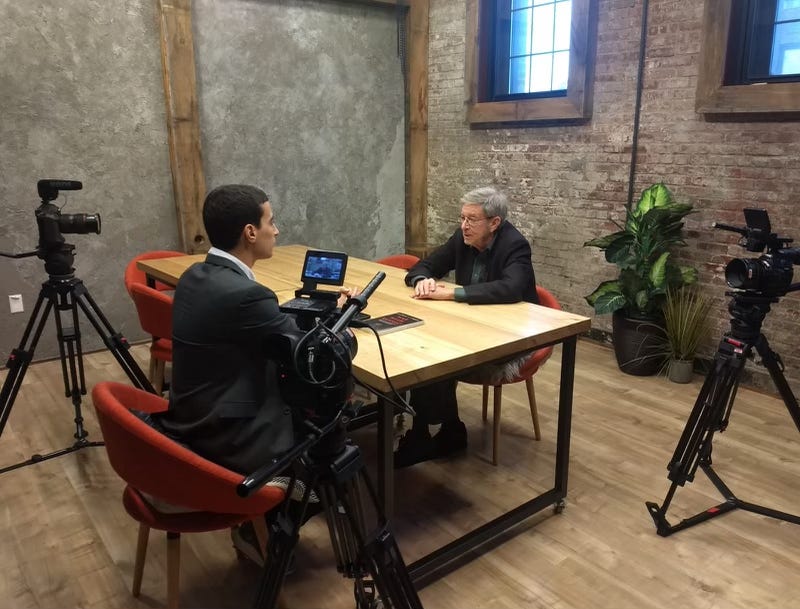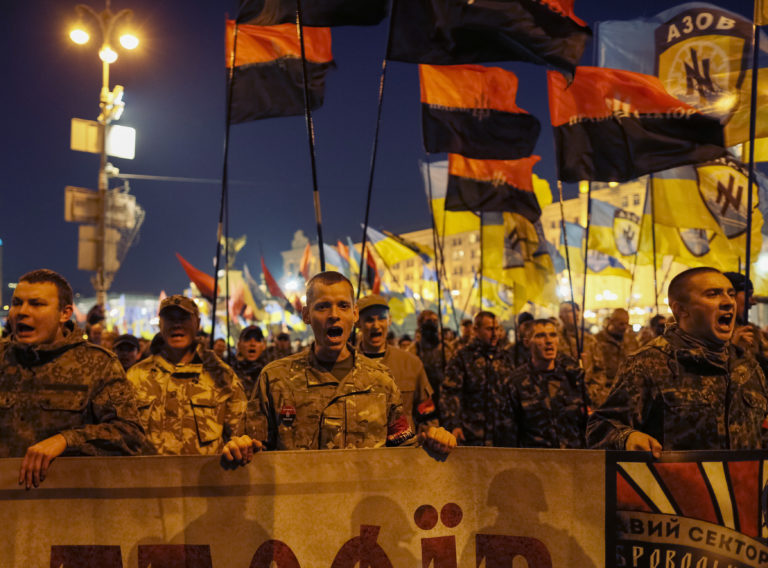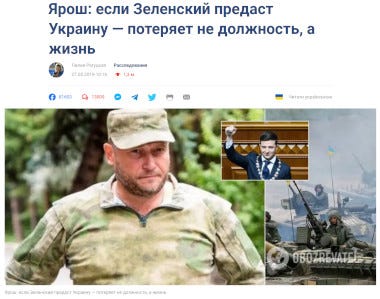
Zelensky was elected on an overwhelming mandate to make peace with Russia.
The US chose to side with Ukraine’s far-right and fuel war.
How US Sabotaged Zelensky’s Mandate for Peace
Aaron Maté / SubStack.com
(April 10, 2022) — On a warm October day in 2019, the eminent Russia studies professor Stephen F. Cohen and I sat down in Manhattan for what would be our last in-person interview (Cohen passed away in September 2020 at the age of 81).
The House was gearing up to impeach Donald Trump for freezing weapons shipments to Ukraine while pressuring its government to investigate Joe Biden and his son Hunter. The Beltway media was consumed with frenzy of a presidency in peril. But Professor Cohen, one of the leading Russia scholars in the United States, was concerned with what the impeachment spectacle in Washington meant for the long-running war between the US-backed Ukrainian government and Russian-backed rebels in the Donbas.
At that point, Ukraine’s Volodymyr Zelensky was just months into an upstart presidency that he had won on a pledge to end the Donbas conflict. Instead of supporting the Ukrainian leader’s peace mandate,
Democrats in Congress were impeaching Trump for briefly impeding the flow of weapons that fueled the fight. As his Democratic allies now like to forget, President Obama refused to send these same weapons out of fear of prolonging the war and arming Nazis. By abandoning Obama’s policy, the Democrats, Cohen warned, threatened to sabotage peace and strengthen Ukraine’s far-right.
“Zelensky ran as a peace candidate,” Cohen explained. “He won an enormous mandate to make peace. So, that means he has to negotiate with Vladimir Putin.” But there was a major obstacle. Ukrainian fascists “have said that they will remove and kill Zelensky if he continues along this line of negotiating with Putin… His life is being threatened literally by a quasi-fascist movement in Ukraine.”

Peace could only come, Cohen stressed, on one condition. “[Zelensky] can’t go forward with full peace negotiations with Russia, with Putin, unless America has his back,” he said. “Maybe that won’t be enough, but unless the White House encourages this diplomacy, Zelensky has no chance of negotiating an end to the war. So the stakes are enormously high.”
Aaron Maté @aaronjmate: In October 2019, Stephen F. Cohen (RIP) implored DC to support Zelensky’s peace mandate. “His life is being threatened by a quasi-fascist movement,” Cohen said. “He can’t go forward with full peace negotiations unless America has his back.” Siding with fascists, DC chose war.
The subsequent impeachment trial, and bipartisan US policy since, has made clear that Washington has had no interest in having Zelensky’s back, and every interest in fueling the Donbas war that he had been elected to end. The overwhelming message from Congress, fervently amplified across the US media (including progressive outlets) with next to no dissent, was that when it comes to Ukraine’s civil war, the US saw Ukraine’s far-right as allies, and its civilians as cannon fodder.
The Ukrainian battle against Russian-backed rebels, State Department official and opening impeachment witness George Kent testified, was being waged by the “Ukrainian equivalent of our own Minutemen of 1776.” In his opening statement at Trump’s trial, Democratic impeachment manager Adam Schiff approvingly quoted another Kent line: “The United States aids Ukraine and her people, so that we can fight Russia over there, and we don’t have to fight Russia here.”

Stephen F. Cohen in October 2019.
Aaron Maté @aaronjmate: If you don’t want Russia to fight Ukraine over there, don’t use Ukraine to fight Russia from here. February 26th 2022
Although Trump’s impeachment failed to remove him from office, it succeeded in cementing the proxy war aims of its chief proponents: rather than support Zelensky’s peace mandate, Ukraine would instead be used to “fight Russia over there.”
In using Ukraine to bleed Russia, the US has showcased its contempt for everything in Ukraine that it claims to defend, namely its democracy and security. By treating Ukraine as a depot for US weapons, the US has joined Ukrainian fascists in sabotaging the 2015 Minsk accords that could have put an end to the civil war triggered by a US-backed coup the year prior.
Minsk called for granting Ukraine’s Russian-speaking population in the eastern Donbas limited autonomy and respect for their language. This prospect was a non-starter for the far-right nationalists and Nazis empowered by the 2014 US-backed Maidan coup.
“The uncomfortable truth is that a sizeable portion of Kiev’s current government — and the protesters who brought it to power — are, indeed, fascists,” two specialists with prominent Western think tanks wrote in Foreign Policy in March 2014, one month after the coup.
The fascists have blocked peace in the Donbas at every turn. When the Ukrainian government voted on a “special law” advancing the Minsk accords in August 2015, the Svoboda party and other far-right groups led violent clashes that killed three Ukrainian soldiers and left dozens wounded.
Then-Ukrainian President Petro Poroshenko, who had signed Minsk at a time when President Obama was resisting heavy bipartisan pressure to arm Ukraine, got the message and refused to uphold Ukraine’s end of the bargain.
In April 2019, Zelensky was elected with an overwhelming 73% of the vote on a promise to turn the tide. In his inaugural address the next month, Zelensky declared that he was “not afraid to lose my own popularity, my ratings,” and was “prepared to give up my own position – as long as peace arrives.”

But Ukraine’s powerful far-right and neo-Nazi militias made clear to Zelensky that reaching peace in the Donbas would have a much higher cost.
“No, he would lose his life,” Right Sector co-founder Dmytro Anatoliyovych Yarosh, then the commander of the Ukrainian Volunteer Army, responded one week after Zelensky’s inaugural speech. “He will hang on some tree on Khreshchatyk — if he betrays Ukraine and those people who died in the Revolution and the War.”
May 2019 headline: “Yarosh: if Zelensky betrays Ukraine, he will lose not his position, but his life”

Along with the threats to his life, Zelensky experienced direct obstacles to his peace mandate on multiple fronts.
When Zelensky travelled to the Donbas in October 2019 to promote elections for the rebel-held areas, he was confronted by angry members of the neo-Nazi Azov battalion rallying under the slogan of “No to Capitulation.” In one exchange caught on video, Zelensky sparred with an Azov member over the president’s calls for a military drawdown. “I’m the president of this country. I’m 41 years old. I’m not a loser. I came to you and told you: remove the weapons,” Zelensky pleaded.
Denis Rogatyuk @DenisRogatyuk: #UkraineRussiaWar: This video is from 2019. It shows a confrontation between Zelensky and a member of Azov battalion in the Donbas region. Zelensky demands that the neo-nazis lay down their arms. The fighter refuses. Zelensky is NOT running the show. The neo-nazis are.
But Zelensky met continued defiance. The same far-right forces set up an armed checkpoint to delay a Ukrainian military pullback. Thousands of far-right and nationalist protesters, cheered by the liberal intelligentsia and carrying flares as torches, also marched in Kiev.

Ukrainian Nazis marched in Kiev.
When Zelensky’s press secretary, Iuliia Mendel, “drew attention to the prevalence of civilian casualties” in the Donbas, “which she blamed on government forces’ injudicious use of return fire,” she was greeted instead with “a prosecutorial summons,” Katharine Quinn-Judge of the International Crisis Group reported in April 2020, one year after Zelensky’s election.
Mendel’s recognition of the suffering in the Donbas, Quinn-Judge observed, resulted from “Zelensky’s campaign pledge to treat residents of Russia-backed enclaves more like full-fledged Ukrainians,” – a non-starter for the US-favored far-right nationalists, who harbored no such interest in Ukrainians’ equality.
Although Zelensky dithered on Minsk, he nonetheless continued talks on its implementation. The far-right continued to express its violent opposition at every turn, such as in August 2021, when at least eight police officers were wounded in armed protests outside the presidential offices.
The far-right threats to Zelensky undoubtedly thwarted a peace agreement that could have prevented the Russian invasion. Just two weeks before Russia troops entered Ukraine, the New York Times noted that Zelensky “would be taking extreme political risks even to entertain a peace deal” with Russia, as his government “could be rocked and possibly overthrown” by far-right groups if he “agrees to a peace deal that in their minds gives too much to Moscow.”
Yuri Hudymenko, leader of the far-right Democratic Ax, even threatened Zelensky with an outright coup: “If anybody from the Ukrainian government tries to sign such a document, a million people will take to the streets and that government will cease being the government.”

Zelensky has clearly gotten the message. Instead of pursuing the peace platform that he was elected on, the Ukrainian President has instead made alliances with the Ukrainian far-right that violently opposed it. As recently as late January, amid last-chance talks to salvage the Minsk accords, Zelensky-appointed Ukrainian security chief Oleksiy Danilov instead pronounced that “the fulfillment of the Minsk agreement means the country’s destruction.” At the final round of Minsk talks in February, just two weeks before Russia’s invasion, a “key obstacle,” the Washington Post reported, “was Kyiv’s opposition to negotiating with the pro-Russian separatists.”
Zelensky’s acquiescence to Nazi forces was most recently underscored on April 7th, when an address to the Greek parliament was overshadowed by his airing of a video featuring a member of the neo-Nazi Azov battalion.
“I think Zelensky found out very quickly that because of the Ukrainian right, it was impossible to implement Minsk II,” John Mearsheimer, the University of Chicago professor and outspoken critic of US policies in Ukraine, said in a public event the same day. “…Zelensky understands that he cannot take the Ukrainian right on by himself. So basically we have a situation where Zelensky is stymied.”
Echoing his late friend and colleague Stephen F. Cohen, Mearsheimer stressed the centrality of the US role.
“The Americans will side with the Ukrainian right,” Mearsheimer said. “Because the Americans, and the Ukrainian right, both do not want Zelensky cutting a deal with the Russians that makes it look like the Russians won. So this is the principal reason that I’m very pessimistic about Ukraine’s ability to help shut this one down.”
Aaron Maté @aaronjmate: This week, John Mearsheimer, speaking to @KatrinaNation, noted the continued alliance between DC and Ukraine’s far-right: “The Americans will side with the Ukrainian right… Both do not want Zelensky cutting a deal with the Russians that makes it look like the Russians won.”
While claiming to profess concern for Ukrainian lives, NATO policymakers have made plain their disregard for diplomacy. Instead, as retired senior US diplomat Chas Freeman recently told me, they have pursued a policy of fighting Russia “to the last Ukrainian.”
“Everything we are doing, rather than accelerate an end to the fighting and some compromise, seems to be aimed at prolonging the fighting,” Freeman, the former Assistant Secretary of Defense for International Security Affairs, said.
Invoking Freeman’s warning, Noam Chomsky concurs that US policy amounts to a “death warrant” for Ukraine.
Aaron Maté @aaronjmate: Chomsky cites my recent interview with veteran US diplomat Chas Freeman, who warned that US policy amounts to fighting Russia “to the last Ukrainian.” (thegrayzone.com/2022/03/24/us-…) Flooding Ukraine with weapons & blocking diplomatic solutions is a “death warrant”, Chomsky says.
Indeed, on April 5, the Washington Post made clear the prevailing viewpoint in Washington and Brussels: “For some in NATO, it’s better for the Ukrainians to keep fighting, and dying, than to achieve a peace that comes too early or at too high a cost to Kyiv and the rest of Europe.”
While rhetorically claiming to support Ukrainian agency, in reality, the Post added, “there are limits to how many compromises some in NATO will support to win the peace.” This is undoubtedly the message being relayed to Zelensky from the White House in what National Security Advisor Jake Sullivan described as “near-daily contact” with Zelensky’s team about the negotiations with Russia.
In short, the US policy is to worsen the Ukraine catastrophe that it could have avoided had it heeded lonely voices like Professor Cohen’s.
“There were moments in history, political history, when there’s an opportunity that is so good and wise and so often lost, the chance,” Cohen told me in October 2019. “So, the chance for Zelensky, the new president who had this very large victory, 70 plus percent to negotiate with Russia an end to that war, it’s got to be seized. And it requires the United States, basically, simply saying to Zelensky, ‘Go for it, we’ve got your back.'”
By choosing instead to have the back of Ukraine’s far-right, Washington sabotaged a historic peace mandate and provoked a catastrophic war.
Posted in accordance with Title 17, Section 107, US Code, for noncommercial, educational purposes